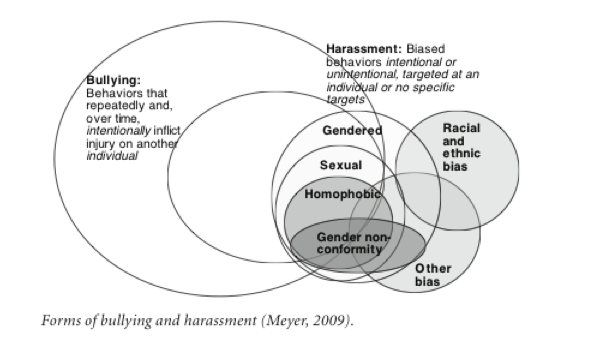.png) Despite steady growth in bullying research since the 1970s, the subject of gender and sexuality in relationship to bullying has largely been ignored. Yet this topic must be examined in order to make schools safer and more inclusive for all students.
Despite steady growth in bullying research since the 1970s, the subject of gender and sexuality in relationship to bullying has largely been ignored. Yet this topic must be examined in order to make schools safer and more inclusive for all students. The following are excerpts from the Prevention of Bullying in Schools, Colleges, and Universities Report conducted by The American Education Research Association on latest gender-related bullying research and how we can stop it.
Gendered harassment is any unwanted behavior that enforces traditional, heterosexual gender norms. It is related to, and can overlap with, bullying. Forms of gendered harassment include sexual harassment; homophobic, biphobic, or transphobic harassment; and harassment for gender-nonconformity (Meyer, 2008, 2009).
State of Knowledge
We know the following about bullying and harassment in schools:
-
The first study that used the same instruments to compare rates and impacts of bullying and sexual harassment showed that students experience high rates of both bullying (52%) and sexual harassment (34%) (Gruber & Fineran, 2008).
-
Gay, lesbian, bisexual, and questioning students experienced more bullying (79% versus 50%) and more sexual harassment than heterosexual students (Coker, Austin, & Schuster, 2010; Gruber & Fineran, 2008; Poteat, Mereish, DiGiovanni, & Koenig, 2011).
-
Teachers are less likely to intervene in harassment related to sexual orientation, gender presentation, and body size than in that related to other forms of bias (race, religion, disability; California Safe Schools Coalition, 2004).
-
Research indicates that students feel safer and report less harassment in schools where specific groups are listed as protected by anti-bullying laws and policies (Hatzenbuehler, 2011; Kosciw, Greytak, Diaz, & Bartkiewicz, 2010).
Legal Issues
The distinctions between bullying and harassment are important because they have different legal implications. Gendered harassment must be addressed in accordance with federal guidelines that are part of Title IX. In October 2010, the U.S. Department of Education’s Office for Civil Rights issued guidance to all school districts in the form of a “Dear Colleague” letter. In this letter there is clear wording regarding how Title IX applies in such cases:
Title IX prohibits harassment of both male and female students regardless of the sex of the harasser—i.e., even if the harasser and target are members of the same sex. It also prohibits gender-based harassment, which may include acts of verbal, non- verbal, or physical aggression, intimidation, or hostility based on sex or sex-stereotyping. Thus, it can be sex discrimination if students are harassed either for exhibiting what is perceived as a stereotypical characteristic for their sex, or for failing to conform to stereotypical notions of masculinity and femininity. Title IX also prohibits sexual harassment and gender-based harassment of all students, regardless of the actual or perceived sexual orientation or gender identity of the harasser or target. (Office for Civil Rights, U.S. Department of Education, 2010, pp. 7–8)
Conclusions and Implications

Studies make clear that awareness about gender-related bullying and broad-based knowledge of what is protected can increase students’ sense of safety and student reports of less harassment. Policy and research implications follow from this knowledge.
Policy
-
Local: School districts need to revise their bullying and harassment policies to explicitly include all forms of gendered harassment (sexual, sexual orientation, and gender identity/expression). Policies need to have clear implementation, reporting, and response mechanisms and align with federal laws, specifically Title IX. Educating staff, students, and families about policy revisions is an essential step for successful implementation.
-
Local: Intervention programs need specifically to identify and teach about different forms of harassment and how these can be addressed along with general anti-bullying initiatives.
-
Federal: Passage of federal bills that explicitly set forth specific groups covered under harassment, such as the Safe Schools Improvement Act (H.R. 1648) and the Student Non-Discrimination Act (H.R. 998), can have observable and meaningful benefits for the well-being of those vulnerable to gender-based harassment.
Read the full report here.